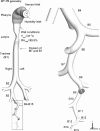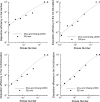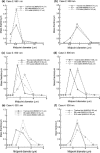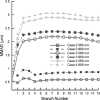Characterization of respiratory drug delivery with enhanced condensational growth using an individual path model of the entire tracheobronchial airways
- PMID: 21152983
- PMCID: PMC3042232
- DOI: 10.1007/s10439-010-0223-z
Characterization of respiratory drug delivery with enhanced condensational growth using an individual path model of the entire tracheobronchial airways
Abstract
The objective of this study was to evaluate the delivery of inhaled pharmaceutical aerosols using an enhanced condensational growth (ECG) approach in an airway model extending from the oral cavity to the end of the tracheobronchial (TB) region. The geometry consisted of an elliptical mouth-throat (MT) model, the upper TB airways extending to bifurcation B3, and a subsequent individual path model entering the right lower lobe of the lung. Submicrometer monodisperse aerosols with diameters of 560 and 900 nm were delivered to the mouth inlet under control (25 °C with subsaturated air) or ECG (39 or 42 °C with saturated air) conditions. Flow fields and droplet characteristics were simulated using a computational fluid dynamics model that was previously demonstrated to accurately predict aerosol size growth and deposition. Results indicated that both the control and ECG delivery cases produced very little deposition in the MT and upper TB model (approximately 1%). Under ECG delivery conditions, large size increases of the aerosol droplets were observed resulting in mass median aerodynamic diameters of 2.4-3.3 μm exiting B5. This increase in aerosol size produced an order of magnitude increase in aerosol deposition within the TB airways compared with the controls, with TB deposition efficiencies of approximately 32-46% for ECG conditions. Estimates of downstream pulmonary deposition indicted near full lung retention of the aerosol during ECG delivery. Furthermore, targeting the region of TB deposition by controlling the inlet temperature conditions and initial aerosol size also appeared possible.
Figures










Similar articles
-
Use of computational fluid dynamics deposition modeling in respiratory drug delivery.Expert Opin Drug Deliv. 2019 Jan;16(1):7-26. doi: 10.1080/17425247.2019.1551875. Epub 2018 Dec 10. Expert Opin Drug Deliv. 2019. PMID: 30463458 Free PMC article. Review.
-
Evaluation of enhanced condensational growth (ECG) for controlled respiratory drug delivery in a mouth-throat and upper tracheobronchial model.Pharm Res. 2010 Sep;27(9):1800-11. doi: 10.1007/s11095-010-0165-z. Epub 2010 May 8. Pharm Res. 2010. PMID: 20454837 Free PMC article.
-
Targeting aerosol deposition to and within the lung airways using excipient enhanced growth.J Aerosol Med Pulm Drug Deliv. 2013 Oct;26(5):248-65. doi: 10.1089/jamp.2012.0997. Epub 2013 Jan 3. J Aerosol Med Pulm Drug Deliv. 2013. PMID: 23286828 Free PMC article.
-
CFD simulations of enhanced condensational growth (ECG) applied to respiratory drug delivery with comparisons to in vitro data.J Aerosol Sci. 2010 Aug 1;41(8):805-820. doi: 10.1016/j.jaerosci.2010.04.006. J Aerosol Sci. 2010. PMID: 20835406 Free PMC article.
-
In silico models of aerosol delivery to the respiratory tract - development and applications.Adv Drug Deliv Rev. 2012 Mar 30;64(4):296-311. doi: 10.1016/j.addr.2011.05.009. Epub 2011 May 27. Adv Drug Deliv Rev. 2012. PMID: 21640772 Free PMC article. Review.
Cited by
-
Development of characteristic upper tracheobronchial airway models for testing pharmaceutical aerosol delivery.J Biomech Eng. 2013 Sep;135(9):91010. doi: 10.1115/1.4024630. J Biomech Eng. 2013. PMID: 23722698 Free PMC article.
-
In vitro dose comparison of Respimat® inhaler with dry powder inhalers for COPD maintenance therapy.Int J Chron Obstruct Pulmon Dis. 2017 May 26;12:1565-1577. doi: 10.2147/COPD.S115886. eCollection 2017. Int J Chron Obstruct Pulmon Dis. 2017. PMID: 28603412 Free PMC article.
-
Airway responsiveness depends on the diffusion rate of methacholine across the airway wall.J Appl Physiol (1985). 2012 May;112(10):1670-7. doi: 10.1152/japplphysiol.00703.2011. Epub 2012 Mar 1. J Appl Physiol (1985). 2012. PMID: 22383507 Free PMC article.
-
Use of computational fluid dynamics deposition modeling in respiratory drug delivery.Expert Opin Drug Deliv. 2019 Jan;16(1):7-26. doi: 10.1080/17425247.2019.1551875. Epub 2018 Dec 10. Expert Opin Drug Deliv. 2019. PMID: 30463458 Free PMC article. Review.
-
Devices for Improved Delivery of Nebulized Pharmaceutical Aerosols to the Lungs.J Aerosol Med Pulm Drug Deliv. 2019 Oct;32(5):317-339. doi: 10.1089/jamp.2018.1508. Epub 2019 Jul 9. J Aerosol Med Pulm Drug Deliv. 2019. PMID: 31287369 Free PMC article. Review.
References
-
- Asgharian B, Price OT. Airflow distribution in the human lung and its influence on particle deposition. Inhal. Toxicol. 2006;18:795–801. - PubMed
-
- Asgharian B, Price OT, Hofmann W. Prediction of particle deposition in the human lung using realistic models of lung ventilation. Aerosol Sci. 2006;37:1209–1221.
-
- Azarmi S, Roa WH, Lobenberg R. Targeted delivery of nanoparticles for the treatment of lung diseases. Adv. Drug Deliv. Rev. 2008;60:863–875. - PubMed
-
- Borgstrom L, Olsson B, Thorsson L. Degree of throat deposition can explain the variability in lung deposition of inhaled drugs. J. Aerosol Med. 2006;19:473–483. - PubMed
-
- Byron PR. Drug delivery devices: issues in drug development. Proc. Am. Thorac. Soc. 2004;1:321–328. - PubMed
Publication types
MeSH terms
Substances
Grants and funding
LinkOut - more resources
Full Text Sources
Other Literature Sources

